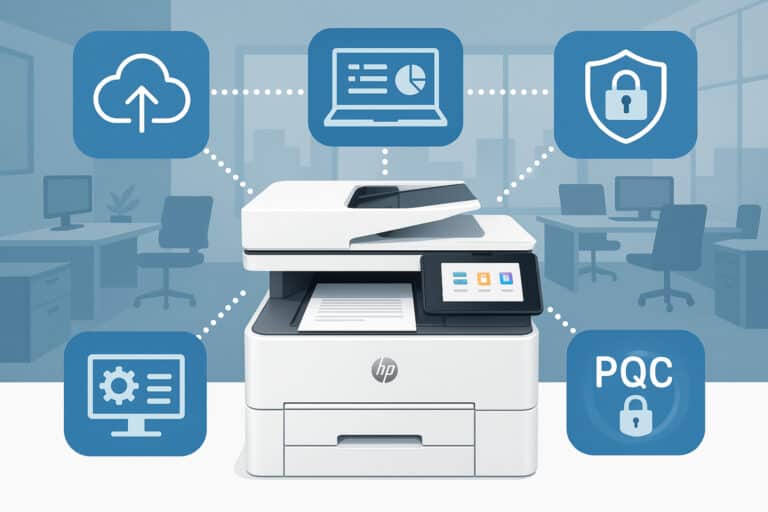Competition in the printer market is fierce. There are still many players active in this declining market. This drives innovation, at least at HP. In this article, we take a closer look at that innovation. Software, AI, security, and the Workforce Experience Platform play an important role, as we will see.
In 2023, we published an article on the state of affairs at HP with regard to the printing market at that time. HP had just launched a new toner and was placing considerable emphasis on sustainability. In the field of Managed Print Services (MPS), we concluded that there was still a lot to be gained. HP really needed to take steps in this area.
Now, two years later, we spoke with Jeroen de Meer, Manager Print Category at HP Benelux, about the role of printing within HP’s vision and the developments taking place in the product range. A lot has happened in recent years. HP has also made good progress in the field of MPS.
The office looks different than it used to
Compared to our previous conversation, one of the main trends and challenges for HP has not really changed. That is the hybrid workplace. Whereas just after Covid, the focus was mainly on boosting sales and catching up, the focus is now mainly on setting up and managing the hybrid workplace. “The entire printing market is still looking for a good solution for hybrid workplaces,” says De Meer. The impact of the forced shift to working from home and the hybrid workplace that has emerged as a permanent feature of the new normal is still being felt.
Hybrid workplaces raise a number of questions. De Meer lists a few of them: “How can you ensure that this workplace is secure and sustainable? How do you ensure that everything is connected? How can you integrate the workplaces in the office and at home?” These questions also need to be answered from a printing perspective.
The answers do not primarily lie in hardware…
Answers to questions such as those above rarely consist solely of new hardware. Printers and MFPs themselves are still important, of course, but “in principle, all suppliers can deliver good products,” says De Meer.
However, HP is clearly ahead of the pack, he immediately adds. This is particularly true in the areas of security and sustainability. He points to the addition of Post-Quantum Cryptography (PQC) to the new A3 line earlier this year (more on this later in this article). Furthermore, HP focuses not only on the energy consumption of the machines themselves, but also on the sustainability of the entire supply chain. For example, there is now a refurbishment program through which HP actively recovers old machines, refurbishes them, and puts them back on the market.
…but especially in software and services
Although HP is best known for manufacturing products ranging from laptops to meeting room equipment and printers, that does not mean it does not invest in and innovate software and services. AI plays an important role in this in several ways. For example, Smart Devices Services (SDS) connects all printers to an HP network using various sensors. This enables preventive maintenance using machine learning.
In addition to using AI for preventive maintenance, HP has also made great strides in its everyday use. “AI will ensure that you have to think even less about printers, because they will become even easier to use,” says De Meer. Earlier this year, the company demonstrated several possibilities for using AI in this way. One of the demos showed how easy it is to redact parts of a text before printing.
Important role for partners
HP develops the necessary software and services itself, but also does a lot in collaboration with partners. Where we see other players in this market building huge document management software stacks or getting started with cloud drivers themselves, HP is looking at this much more in collaboration with channel partners and technology partners. “We like to work with partners who can also add their services,” says De Meer. These partners then offer MPS with their own twist.
During our conversation, De Meer also gives an example of a collaboration between HP and a large software supplier. Together with Epic (a supplier of software to hospitals in particular), HP has built a joint solution that links HP’s hardware to Epic’s software. This has resulted in a specific solution for hospitals.
It is clear how HP thinks about software. It does not lose itself in building large stacks that are too far removed from the company’s core qualities, but seeks collaboration. This enables it to offer a very broad and strong portfolio, including through partners. This approach gives HP a much greater reach than if it were to develop everything itself. Of course, it is important to maintain all these partnerships at a high level. That is the downside of not doing everything in-house.
Workforce Experience Platform
One of HP’s most important recent innovations is the Workforce Experience Platform (WXP). This is the company’s DEX (Digital Employee Experience) solution. It monitors the performance of PCs, printers, conferencing equipment, and other devices to enable employees to work optimally. The idea is that well-performing equipment leads to satisfied employees. And satisfied employees are ultimately better for the organization as a whole than dissatisfied employees.
AI plays an important role in WXP. SDS, which we mentioned above, springs to mind here. “We have taken this and integrated it into the platform. It helps customers and partners gain a general insight into the entire fleet,” explains De Meer. Based on the insights provided by WXP, organizations can carry out preventive repairs or replace parts.
It should be noted that this is not just about monitoring HP equipment. The platform is hardware-agnostic. This is certainly important in hybrid work environments. Most organizations will encounter many different brands, especially in such work environments. This is certainly the case if people are allowed to use their own equipment when working remotely or occasionally working from home.
WXP also fits in very well with HP’s overall vision. “HP’s vision is to provide the entire workplace for customers, with the best connections between products,” says De Meer. Managed services such as MPS play an important role in this. Such services naturally benefit greatly from the insights and actions that arise from a platform such as WXP. The experience with MPS, a pioneer when it comes to offering services instead of products, is now also helping to develop managed services for meeting rooms.
HP wants and needs to offer more than its competitors
It is clear that a lot is happening in the field of printing at HP at the moment. “Print is simply a very trendy market, a pioneer,” says De Meer with more than a little tongue in cheek. That is partly meant to be funny, of course, but the printing market in 2025 is a lot more innovative than it has been for a long time. New ways of working (hybrid workplaces) combined with technological developments (WXP, AI, and security) are driving unprecedented innovation in the printing market. The challenge for HP now is to bring this to the attention of its customers.

De Meer sees in practice how important it is to inform customers. He regularly encounters organizations that want something that is actually impossible. “Companies that want to reduce their number of printers from 100 to 50, but forget that this is actually impossible due to the demand for printers in work processes,” he gives as an example from daily practice. In such cases, an organization must first have a clear picture of its work processes. It can then make any necessary adjustments, and only then can the number of printers be halved. Or it may become clear that it is simply not possible and that 75 printers are still needed, for example.
The insights needed to determine what is and isn’t possible come from the aforementioned WXP, among other sources. It includes an Insights component that HP and partners can run in a customer’s environment. This provides insight into where organizations can save money and which offering best suits a customer. This concerns the initial offering for the products, but also the MPS component.
Security is becoming even more important
Incidentally, it is certainly not just software that HP wants to use to make a difference. We mentioned security earlier in this article. This has been an important component of HP hardware for many years, including printers. Looking to the future, De Meer sees an important role for something that HP has been involved in from the very beginning: PQC support on printers.
HP expects support for post-quantum cryptography to become more or less mandatory in the foreseeable future. From 2030, the US government will no longer purchase machines that do not have this. “The rest of the world will follow suit,” says De Meer. He also says that he already talks to customers about PQC on a regular basis. So it’s good news that the first models to support it have recently been announced. De Meer expects HP to update its portfolio fairly quickly in this regard.
Adding PQC now could also give HP a nice extra opening in conversations with customers or potential customers. Many of them are already in talks with HP and/or partners to see what’s possible before their (MPS) contract ends. It is possible to keep printer firmware up to date, even for older generations, using HP FutureSmart. However, organizations that have made PQC and security in general an important theme can now also opt for models with PQC support. That could be quite interesting.
“HP is definitely here to stay”
Finally, if we look at the bigger picture, market developments and HP’s innovations will eventually lead to consolidation in the printer market. You can already see this happening. There’s M&A activity between various players in the market, and some others withdraw from specific markets. Those are tell-tale signs of consolidation.
“HP is definitely here to stay,” says De Meer. The company sees the printer as an integral part of the hybrid workplace and can supply multiple components for it. If we link this to developments in software, partnerships, AI, and security, the future for HP in this market segment actually looks quite bright. That may be a strange thing to say about a market that is still declining overall. However, it is also changing drastically. That is different from disappearing and offers opportunities for suppliers who are willing and able to take a new approach.
What goes for HP, also goes for the market for printers and multifunctional devices in general. That market is certainly here to stay too. At least for the near or even medium future. HP is responding well to this with an overarching vision that puts the emphasis in the right places. If HP executes this vision well, together with partners and with the help of MPS, it will be one of a few companies able to keep up with the drastic changes in the market. In fact, printers could play a more important role in HP’s overall workplace story than you might expect today.
